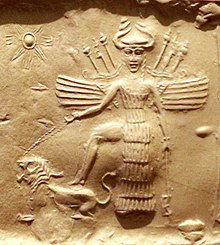 Global Information
Global InformationInanna information
| Inanna(Ishtar) | |
|---|---|
| |
 Goddess Ishtar on an Akkadian Empire seal, 2350–2150 BCE. She is equipped with weapons on her back, has a horned helmet, places her foot in a dominant posture upon a lion secured by a leash and is accompanied by the star of Shamash. | |
| Major cult center | Uruk; Agade; Nineveh |
| Abode | Heaven |
| Planet | Venus |
| Symbol | hook-shaped knot of reeds, eight-pointed star, lion, rosette, dove |
| Mount | Lion |
| Personal information | |
| Parents |
sometimes An or Enlil Enki more rarely[2] |
| Siblings |
|
| Consort | Dumuzid, Sargon of Akkad, Zababa |
| Children | Possibly Nanaya |
| Equivalents | |
| Greek equivalent | Aphrodite |
| Roman equivalent | Venus |
| Canaanite equivalent | Astarte |
| Elamite equivalent | Pinikir |
| Hurrian equivalent | Shaushka |
| Mandaean equivalent | Libat |
| Egyptian equivalent | Isis |
Inanna[a] is the ancient Mesopotamian goddess of love, war, and fertility. She is also associated with sensuality, procreation, divine law, and political power. Originally worshiped in Sumer, she was known by the Akkadian Empire, Babylonians, and Assyrians as Ishtar[b] (and occasionally the logogram 𒌋𒁯). Her primary title was "the Queen of Heaven".
She was the patron goddess of the Eanna temple at the city of Uruk, her early main cult center. In archaic Uruk she was worshiped in three forms: morning Inanna (Inana-UD/hud), evening Inanna (Inanna sig) and princely Inanna (Inanna NUN), the former two reflecting the phases of her associated planet Venus.[5][6] Her most prominent symbols included the lion and the eight-pointed star. Her husband was the god Dumuzid (later known as Tammuz), and her sukkal (attendant) was the goddess Ninshubur, later conflated with the male deities Ilabrat and Papsukkal.
Inanna was worshiped in Sumer at least as early as the Uruk period (c. 4000 BCE – 3100 BCE), and her cultic activity was relatively localized before the conquest of Sargon of Akkad. During the post-Sargonic era, she became one of the most widely venerated deities in the Sumerian pantheon,[7][8] with temples across Mesopotamia. The cult of Inanna/Ishtar, which may have been associated with a variety of sexual rites, was continued by the East Semitic-speaking peoples (Akkadians, Assyrians and Babylonians) who succeeded and absorbed the Sumerians in the region.
She was especially beloved by the Assyrians, who elevated her to become the highest deity in their pantheon, ranking above their own national god Ashur. Inanna / Ishtar is alluded to in the Hebrew Bible, and she greatly influenced the Ugaritic goddess Ashtart and later the Phoenician goddess Astarte, who in turn possibly influenced the development of the Greek goddess Aphrodite. Her cult continued to flourish until its gradual decline between the first and sixth centuries CE in the wake of Christianity.
Inanna appears in more myths than any other Sumerian deity.[9][10][11] She also had a uniquely high number of epithets and alternate names, comparable only to Nergal.[12]
Many of her myths involve her taking over the domains of other deities. She was believed to have been given the mes, which represented all positive and negative aspects of civilization, by Enki, the god of wisdom. She was also believed to have taken over the Eanna temple from An, the god of the sky. Alongside her twin brother Utu (later known as Shamash), Inanna was the enforcer of divine justice; she destroyed Mount Ebih for having challenged her authority, unleashed her fury upon the gardener Shukaletuda after he raped her in her sleep, and tracked down the bandit woman Bilulu and killed her in divine retribution for having murdered Dumuzid. In the standard Akkadian version of the Epic of Gilgamesh, Ishtar asks Gilgamesh to become her consort. When he disdainfully refuses, she unleashes the Bull of Heaven, resulting in the death of Enkidu and Gilgamesh's subsequent grapple with his own mortality.
Inanna's most famous myth is the story of her descent into and return from the ancient Mesopotamian underworld, ruled by her older sister Ereshkigal. After she reaches Ereshkigal's throne room, the seven judges of the underworld deem her guilty and strike her dead. Three days later, Ninshubur pleads with all the gods to bring Inanna back. All of them refuse her, except Enki, who sends two sexless beings to rescue Inanna.
They escort Inanna out of the underworld but the galla, the guardians of the underworld, drag her husband Dumuzid down to the underworld as her replacement. Dumuzid is eventually permitted to return to heaven for half the year, while his sister Geshtinanna remains in the underworld for the other half, resulting in the cycle of the seasons.
- ^ Asher-Greve & Westenholz (2013), p. 230.
- ^
Electronic Corpus of Sumerian Literature ETCSL "Inanna and Enki" – lines: 76–87. (Inanna addresses Enki as: "my father" and Enki himself is regarded in the third person as Inanna's father, as stated by Enki's minister Isimud who calls him: "your father" while talking to Inanna). - ^ a b Heffron (2016a).
- ^ "Sumerian dictionary". oracc.iaas.upenn.edu.
- ^ Steinkeller, Piotr, "Archaic City Seals and the Question of Early Babylonian Unity" in Riches Hidden in Secret Places: Ancient Near Eastern Studies in Memory of Thorkild Jacobsen, edited by Tzvi Abusch, University Park, USA: Penn State University Press, pp. 249–258, 2002
- ^ Szarzyńska, Krystyna, "Offerings for the Goddess Inana in Archaic Uruk", Revue d’Assyriologie et d’archéologie Orientale, vol. 87, no. 1, pp. 7–28, 1993
- ^ Wolkstein & Kramer (1983), p. xviii.
- ^ Nemet-Nejat (1998), p. 182.
- ^ Wolkstein & Kramer (1983), p. xv.
- ^ Penglase (1994), pp. 42–43.
- ^ Kramer (1961), p. 101.
- ^ Wiggermann (1999), p. 216.
Cite error: There are <ref group=lower-alpha> tags or {{efn}} templates on this page, but the references will not show without a {{reflist|group=lower-alpha}} template or {{notelist}} template (see the help page).